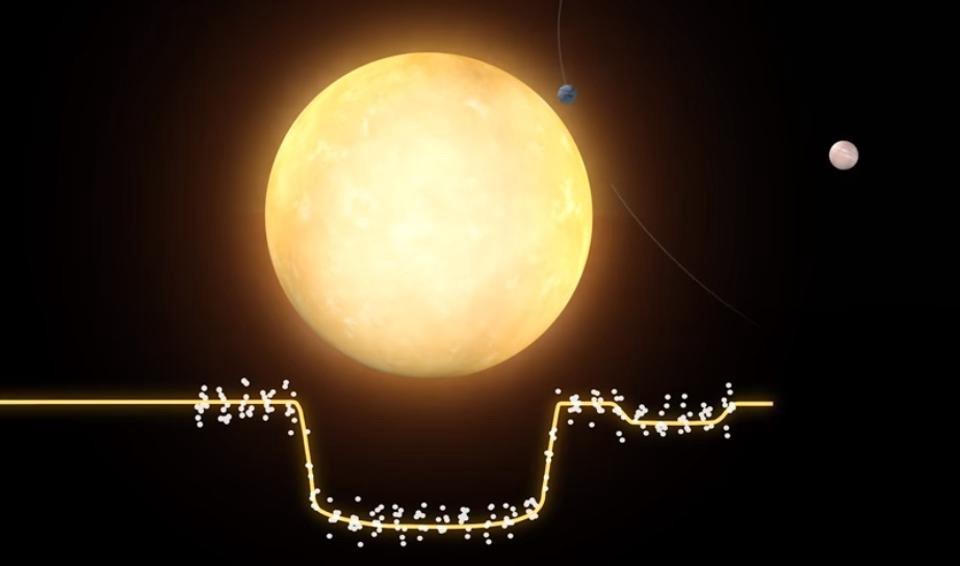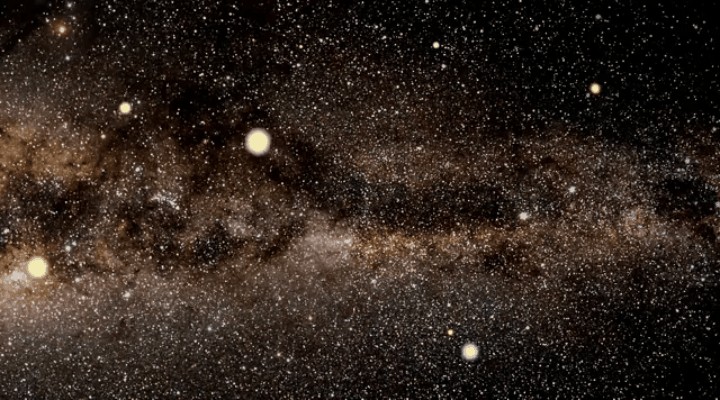How many planets are there in the universe? It’s a question that has captivated scientists and stargazers alike for centuries, and thanks to advancements in exoplanet detection, we’re closer than ever to an answer. At HOW.EDU.VN, we connect you with leading experts who can provide in-depth insights into this fascinating field, exploring topics like planetary formation, exoplanet characteristics, and the search for extraterrestrial life. Unlock the expertise to navigate the complexities of exoplanetary science, rogue planets and the possibilities of life beyond Earth.
1. A Universe Teeming With Worlds: The Exoplanet Revolution
For most of human history, our understanding of planets was limited to those within our own Solar System. The idea of planets orbiting other stars, while speculated upon, remained firmly in the realm of science fiction. That all changed in the early 1990s with the discovery of the first exoplanets – planets orbiting stars other than our Sun. This discovery sparked a revolution in astronomy, transforming our understanding of planetary systems and the potential for life beyond Earth.
An artist’s illustration of the young solar system highlights the protoplanetary disk, a key stage in planet formation.
1.1 The Dawn of Exoplanet Discovery
The first exoplanets were detected using the radial velocity method, which measures the “wobble” of a star caused by the gravitational pull of orbiting planets. This method is particularly effective for detecting large, massive planets orbiting close to their stars. However, it wasn’t until the launch of space-based telescopes like NASA’s Kepler mission that the field truly exploded.
1.2 Kepler’s Legacy: A Census of the Galaxy
Kepler used the transit method, which detects planets by observing the slight dimming of a star’s light as a planet passes in front of it. This method allowed Kepler to discover thousands of exoplanets, including many Earth-sized planets in the habitable zones of their stars – the region around a star where liquid water could exist on a planet’s surface.
Kepler’s data revealed that planets are incredibly common in our galaxy. In fact, scientists now estimate that there is, on average, at least one planet per star in the Milky Way. This means that there could be hundreds of billions of planets in our galaxy alone.
2. Methods of Exoplanet Detection: Unveiling Distant Worlds
Scientists use a variety of techniques to detect and study exoplanets, each with its own strengths and limitations. Here’s a look at some of the most common methods:
2.1 Radial Velocity (Doppler Spectroscopy): Detecting Stellar Wobbles
As mentioned earlier, the radial velocity method relies on detecting the slight wobble of a star caused by the gravitational pull of orbiting planets. This wobble causes the star’s light to shift slightly towards the blue end of the spectrum as it moves towards us and towards the red end as it moves away. By measuring these shifts, astronomers can determine the presence of planets, their masses, and their orbital periods.
2.2 Transit Photometry: Watching for Dips in Starlight
The transit method, used by Kepler, detects planets by observing the slight dimming of a star’s light as a planet passes in front of it. The amount of dimming reveals the planet’s size relative to the star, and the time between transits reveals the planet’s orbital period.
Transiting planets cause a periodic dimming of their parent star’s light, allowing astronomers to infer their size and orbital period.
2.3 Direct Imaging: Capturing Exoplanet Portraits
Direct imaging involves taking pictures of exoplanets directly. This is a challenging technique because planets are much fainter than their host stars, and the glare from the star can easily overwhelm the planet’s light. However, advancements in telescope technology and image processing techniques are making direct imaging increasingly feasible.
2.4 Microlensing: Using Gravity as a Magnifying Glass
Microlensing is a technique that uses the gravity of a star to magnify the light from a more distant star. If a planet is orbiting the lensing star, it can create a brief spike in the magnified light, revealing its presence. Microlensing is particularly useful for detecting planets that are far from their stars, including rogue planets that don’t orbit any star at all.
Microlensing events occur when a star’s gravity bends and magnifies the light of a background star, potentially revealing the presence of orbiting planets.
2.5 Astrometry: Precision Measurements of Stellar Positions
Astrometry involves precisely measuring the position of a star over time. If a star has a planet orbiting it, the star will wobble slightly as it orbits the center of mass of the star-planet system. By measuring these tiny wobbles, astronomers can detect the presence of planets.
3. Estimating the Number of Planets: From Our Galaxy to the Observable Universe
Given the vastness of the universe, it’s impossible to count every planet directly. Instead, scientists rely on statistical methods and extrapolations to estimate the total number of planets.
3.1 Planets in the Milky Way: A Statistical Census
Based on data from Kepler and other exoplanet surveys, astronomers estimate that there are at least 100 billion planets in the Milky Way galaxy. This number includes planets orbiting stars, as well as rogue planets that wander through space without a host star.
3.2 Galaxies Beyond: Extrapolating to the Universe
Our observable universe contains an estimated 2 trillion galaxies. If we assume that the Milky Way is a typical galaxy, and that each galaxy contains roughly the same number of planets, we can extrapolate to estimate the total number of planets in the observable universe.
3.3 A Staggering Number: 10^25 Planets and Beyond
Using these estimates, scientists arrive at the staggering conclusion that there are approximately 10^25 planets orbiting stars in the observable universe. Furthermore, the number of rogue planets could be 10 to 10,000 times greater, potentially reaching 10^26 to 10^30.
This number is so large that it’s difficult to comprehend. To put it in perspective, it’s more than the number of grains of sand on all the beaches on Earth.
4. Types of Exoplanets: A Diverse Planetary Zoo
Exoplanets come in a wide variety of sizes, masses, and compositions. Some are similar to the planets in our own Solar System, while others are unlike anything we’ve ever seen.
4.1 Hot Jupiters: Gas Giants Close to Their Stars
Hot Jupiters are gas giant planets that orbit very close to their stars, with orbital periods of just a few days. These planets are thought to have formed further out in their systems and then migrated inward.
4.2 Super-Earths: Rocky Worlds Larger Than Earth
Super-Earths are rocky planets that are larger and more massive than Earth, but smaller than Neptune. These planets are particularly interesting because they may be more likely to be habitable than Earth-sized planets.
4.3 Mini-Neptunes: Gas Giants Smaller Than Neptune
Mini-Neptunes are gas giant planets that are smaller than Neptune. These planets have thick atmospheres and may have rocky cores.
4.4 Rogue Planets: Wanderers of the Galaxy
Rogue planets are planets that have been ejected from their star systems or that formed independently in interstellar space. These planets are difficult to detect, but they may be very common in the galaxy.
5. The Search for Habitable Worlds: Are We Alone?
One of the most exciting aspects of exoplanet research is the search for habitable worlds – planets that could potentially support life.
5.1 The Habitable Zone: Where Liquid Water Can Exist
The habitable zone is the region around a star where the temperature is right for liquid water to exist on a planet’s surface. Liquid water is considered essential for life as we know it, so planets in the habitable zone are prime targets in the search for extraterrestrial life.
5.2 Factors Beyond Distance: Atmosphere and Composition
However, habitability is not just about distance from a star. A planet’s atmosphere and composition also play a crucial role. For example, a planet with a thick atmosphere could be much warmer than a planet with a thin atmosphere, even if they are the same distance from their star.
5.3 The Drake Equation: Estimating the Odds of Extraterrestrial Intelligence
The Drake equation is a probabilistic argument used to estimate the number of active, communicative extraterrestrial civilizations in the Milky Way galaxy. While many of the factors in the equation are highly uncertain, it provides a framework for thinking about the odds of finding extraterrestrial intelligence.
: The Drake equation attempts to quantify the number of potentially communicative extraterrestrial civilizations in our galaxy.
6. Future Missions: The Next Generation of Exoplanet Hunters
The search for exoplanets is an ongoing endeavor, and several future missions are planned to continue this exciting research.
6.1 The James Webb Space Telescope: A New Era of Exoplanet Characterization
The James Webb Space Telescope (JWST) is the most powerful space telescope ever built. JWST is capable of studying the atmospheres of exoplanets in unprecedented detail, searching for signs of life.
6.2 The Nancy Grace Roman Space Telescope: Wide-Field Exoplanet Surveys
The Nancy Grace Roman Space Telescope is a wide-field telescope that will be used to conduct large-scale surveys of the sky, including surveys for exoplanets. Roman is expected to discover thousands of new exoplanets, including many Earth-sized planets in the habitable zones of their stars.
6.3 The European Extremely Large Telescope: Ground-Based Exoplanet Imaging
The European Extremely Large Telescope (E-ELT) is a giant ground-based telescope that is currently under construction. The E-ELT will be capable of directly imaging exoplanets, allowing astronomers to study their atmospheres and surfaces in detail.
7. Expert Insights at HOW.EDU.VN: Navigating the Cosmos
Understanding the sheer number of planets in the universe and the potential for life beyond Earth requires navigating complex scientific concepts. HOW.EDU.VN offers a unique platform to connect with leading experts who can provide clarity and guidance.
7.1 Connecting with PhDs: Personalized Guidance
Do you have questions about exoplanet detection methods? Are you curious about the potential for habitability on other worlds? Our team of PhDs is available to provide personalized guidance and answer your specific questions.
7.2 Expert Consultations: Tailored Solutions
Whether you’re a student, researcher, or simply a curious individual, HOW.EDU.VN can connect you with the expertise you need to explore the mysteries of the universe. Our experts offer tailored solutions to help you understand complex topics and stay informed about the latest discoveries.
7.3 Addressing Your Challenges: Finding the Right Expert
Finding reliable information and expert guidance can be challenging. HOW.EDU.VN streamlines the process, connecting you with vetted professionals who can address your specific needs.
7.3.1 Common Challenges Faced By Individuals Seeking Expertise:
| Challenge | HOW.EDU.VN Solution |
|---|---|
| Difficulty finding qualified experts | Vetted network of over 100 PhDs and leading professionals |
| High costs of traditional consulting | Competitive rates and flexible consultation options |
| Concerns about information reliability | Experts with proven track records and affiliations with reputable institutions |
| Difficulty articulating complex questions | User-friendly platform for submitting detailed inquiries and receiving personalized advice |




8. Unlock Expert Guidance Today: Call to Action
The universe is vast and full of wonders, and the discovery of exoplanets has opened up a new era of exploration. At HOW.EDU.VN, we’re committed to providing you with the expert guidance you need to navigate this exciting field.
8.1 Take the Next Step: Consult with Our Experts
Don’t let your questions about exoplanets and the universe go unanswered. Contact HOW.EDU.VN today to connect with our team of PhDs and leading professionals. We’re here to help you unlock the mysteries of the cosmos.
8.2 Contact Us: Your Journey Starts Now
Address: 456 Expertise Plaza, Consult City, CA 90210, United States
WhatsApp: +1 (310) 555-1212
Website: HOW.EDU.VN
An artist’s impression emphasizes that planets are abundant throughout the universe, highlighting the vast potential for discovery.
9. Frequently Asked Questions (FAQ)
9.1 How do scientists estimate the number of planets in the universe?
Scientists use a combination of exoplanet detection data, statistical methods, and extrapolations to estimate the number of planets. They start by estimating the number of planets in our galaxy, the Milky Way, based on data from missions like Kepler. Then, they extrapolate this number to the entire observable universe, taking into account the estimated number of galaxies.
9.2 What is the Drake Equation, and how does it relate to exoplanet research?
The Drake Equation is a probabilistic argument used to estimate the number of active, communicative extraterrestrial civilizations in the Milky Way galaxy. While many of the factors in the equation are highly uncertain, the increasing knowledge about exoplanets is refining certain variables, bringing more focus to this topic.
9.3 What are some of the most promising future missions for exoplanet research?
Some of the most promising future missions include the James Webb Space Telescope (JWST), the Nancy Grace Roman Space Telescope, and the European Extremely Large Telescope (E-ELT). These missions will use a variety of techniques to detect and study exoplanets, including direct imaging, transit photometry, and spectroscopy.
9.4 What is the habitable zone, and why is it important in the search for life?
The habitable zone is the region around a star where the temperature is right for liquid water to exist on a planet’s surface. Liquid water is considered essential for life as we know it, so planets in the habitable zone are prime targets in the search for extraterrestrial life.
9.5 What are rogue planets, and how common are they?
Rogue planets are planets that have been ejected from their star systems or that formed independently in interstellar space. They are difficult to detect, but scientists estimate that they may be even more common than planets orbiting stars.
9.6 How does HOW.EDU.VN connect me with experts on exoplanets?
HOW.EDU.VN has a network of over 100 PhDs and leading professionals in various fields, including astronomy and astrophysics. You can submit your questions or requests for consultation through our platform, and we will connect you with an expert who can provide personalized guidance and answers.
9.7 What are the benefits of consulting with an expert on exoplanets?
Consulting with an expert can provide you with accurate, reliable, and up-to-date information on exoplanets. Experts can also help you understand complex concepts, interpret data, and stay informed about the latest discoveries. Additionally, they can offer insights and perspectives that you may not find in textbooks or online articles.
9.8 What types of questions can I ask an expert on exoplanets?
You can ask experts about a wide range of topics related to exoplanets, including their formation, detection, characterization, habitability, and the search for extraterrestrial life. You can also ask about specific exoplanets, missions, or research projects.
9.9 How can I be sure that the information I receive from an expert on HOW.EDU.VN is reliable?
how.edu.vn carefully vets all of its experts to ensure that they have the necessary qualifications, experience, and expertise. We also encourage users to provide feedback on their consultations to help us maintain the quality of our services.
9.10 What if I have a question that is not answered in the FAQ?
If you have a question that is not answered in the FAQ, you can submit it through our platform, and we will do our best to provide you with an answer. You can also contact us directly via WhatsApp or visit our website for more information.